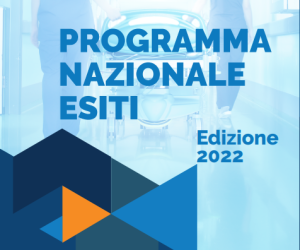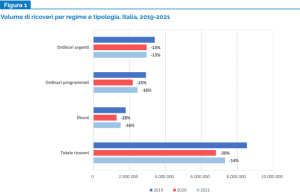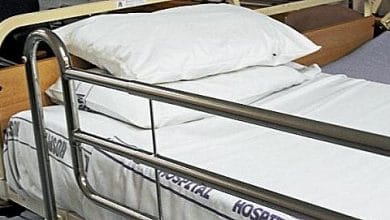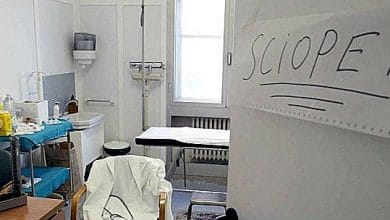
The new report on the performance of NHS structures in 2021 shows us that hospitals are trying to recover after the slowdown caused by the pandemic even if we are still far from the previous levels: lost in two years, 2020 and 2021, 2 million and 900 thousand hospitalizations. But it should also be noted that, thanks to corrections applied in various specialist areas, many realities in the Centre-South have surpassed the traditional excellences of the north. An intervention analysis methodology that bodes well.
National Outcomes Program 2022
The National Outcomes Program (PNE) developed by AGENAS on behalf of the Ministry of Health has the objective of evaluating the effectiveness in practice, appropriateness, equity of access and safety of the treatments guaranteed by the NHS within the scope of the essential levels of assistance (LEA). Probably no European country has equipped itself with a monitoring, analysis and intervention tool as refined as the National Results Program drawn up by Agenas. The underlines it General Manager of Agenas Domenico Mantoan at the end of the presentation conference.
by AGENAS on behalf of the Ministry of Health has the objective of evaluating the effectiveness in practice, appropriateness, equity of access and safety of the treatments guaranteed by the NHS within the scope of the essential levels of assistance (LEA). Probably no European country has equipped itself with a monitoring, analysis and intervention tool as refined as the National Results Program drawn up by Agenas. The underlines it General Manager of Agenas Domenico Mantoan at the end of the presentation conference.
“The PNE highlighted the main elements to consider in order to support the reorganization of the NHS after the pandemic and to contribute to the dissemination of existing good practices and to guide change. The opportunity offered by the National Recovery and Resilience Plan requires a wide-ranging planning effort in which the Regions and individual structures are called to play a concrete role. In order to make optimal use of the resources allocated in implementation of the PNRR, a reorganization of the health supply is needed that is able to create a system that gives punctual responses to the population's prevention and assistance needs. Such a road – adds Mantoan – can only be pursued through a concrete synergy between the various levels of governance of the system”
The first edition of the PNE dates back to ten years ago and since then the indicators used by the Program have been constantly updated and developed, precisely with a view to promptly responding to the changes taking place within the NHS. In 2012 there were 42 indicators, in 2020 they increased to 177, today they have reached 194: 171 relating to hospital assistance (73 of outcome/process, 83 of volume of activity and 15 of hospitalization), 23 relating to territorial assistance (evaluated indirectly in terms of avoidable hospitalization -14 indicators- long-term outcomes -5 indicators- and improper access to the emergency room - 4 indicators).
Even if it will not fail to be presented in this way by the media, the PNE does not produce rankings, rankings, judgements. “The scientific evidence and results provided by the PNE – he maintains Enrico Coscioni, President of AGENAS – confirm that the publication of outcome data is a fundamental tool for governing the system to improve the quality of care, intervening on critical care issues and avoiding the recurrence of problems, in order to fully evaluate the patient care pathway, make the measures more punctual and identify with greater precision the most virtuous structures, to be taken as a benchmark for improvement“.
The announcement is that of starting a new one Evaluation program of strategic directions: under the magnifying glass the performance of managers, administrative and health directors of the individual Health Trusts. The 200 managers who manage the money of the Italian Healthcare.
“The indicators used have been defined in order to show the various stakeholders – continues Coscioni - what results can be achieved and what are the difficulties of the system through the comparative evaluation between the structures and the territorial areas.
Today we look primarily at the 1,377 public and private hospitals, because thehospital is the most established setting, but undoubtedly in perspective, the analysis of the levels of assistance produced at the local level will have to be further refined, no longer evaluated only for hospitalizations avoided.
In the same way, attention is being consolidated to the chapter of inequalities in health care, in particular those of gender and those relating to the foreign population residing in Italy.
The photograph that the PNE 2022 gives us is that of a NHS that is trying to make up for lost time due to the pandemic, but is struggling to get back to previous levels and take note of the limitations that have emerged.
Priorities are the need for intervention on waiting lists created with the pandemic, almost 3 million hospitalizations accumulated in the years 2020-2021, and on territorial disparities, not only inter-regional but also intra-regional.
The four main directions of evaluation:
- the volumes, surgical indicators calculated by institution, single operator and coherent operating unit
- timeliness access to urgent treatments (coronary angioplasty, hip fracture surgery)
- the appropriateness clinical and organizational in the perinatal area and in short cycle surgery;
- the results: clinical parameters to measure the severity of the patient on admission.
In general, the number of urgent hospitalizations was lower than the expected value based on prepandemic trends: -10% for acute myocardial infarction (about 11,300 fewer hospitalizations) and -6% for hip fracture (about 5,800 fewer hospitalizations).
The timeliness of access to urgent treatments remains below the standard of care in over half of the Italian facilities: the proportion of patients undergoing coronary angioplasty (PTCA) within 90 minutes of admission was on average 50.6%, while the proportion of elderly patients with within 48 hours it averaged 48.6%. In both cases, the threshold established by Ministerial Decree 70 is 60%.
Mortality 30 days after a heart attack it decreased slightly in 2021 compared to 2020 (7.7% vs. 8.4%), with a return to the pre-pandemic trend (expected value equal to 7.3%). Mortality 30 days after hospitalization for hip fracture remained stable compared to 2020 (6.4% vs. 6.6%), but is still higher than in the prepandemic period (5.1% in 2019). In the case of heart attacks, the use of additional clinical variables made it possible to significantly modify the ranking of the structures in half of the 357 evaluated for this indicator.
One remains marked inappropriateness in the mother-child environment, for example in the use of caesarean section: in 2021, only 14.1% of maternities with less than 1,000 deliveries/year and 69.7% of those with volumes greater than 1,000 recorded proportions in line with DM 70. Yes they also maintain low proportions of vaginal deliveries after a previous cesarean, with a national median value of 6.7% and a marked North-South gradient.
Oncological care recorded important signs of recovery in 2021. For example, hospitalizations for breast cancer, which in 2020 had decreased by 11% (about 6,000 operations less than expected), have returned to prepandemic levels. As regards the concentration of cases, the 74% of the interventions was carried out in operating units that complied with the threshold set by Ministerial Decree 70 (up compared to the 67% of 2020). If we consider the volume per operator, the share of interventions carried out by expert operators (≥50 interventions/year) is equal to 70%.
Clinical impact of COVID-19 in patients with AMI
Research activity that demonstrates how the PNE, in addition to being a tool for monitoring the quality of health care, also represents an important source of data to be used to describe and interpret the impact on the NHS of anomalous and sudden phenomena, such as in this case the COVID-19 pandemic.
Objective to evaluate the impact of the injection from COVID-19 on the mortality of patients with AMI hospitalized between 11 March and 3 May 2020 (lockdown), compared with equivalent periods of the previous 5 years.
Outcomes: 30-day and 6-month mortality.
Patients with IMA-STEMI and NSTEMI were considered separately.
THE PRICES
For 2021 it was decided to reward two companies that showed high or very high performance on all 18 parameters considered: theAOU of the Marches of Ancona and theHumanitas Clinical Institute of Rozzano.
NATIONAL PROGRAM OUTCOMES 2022







